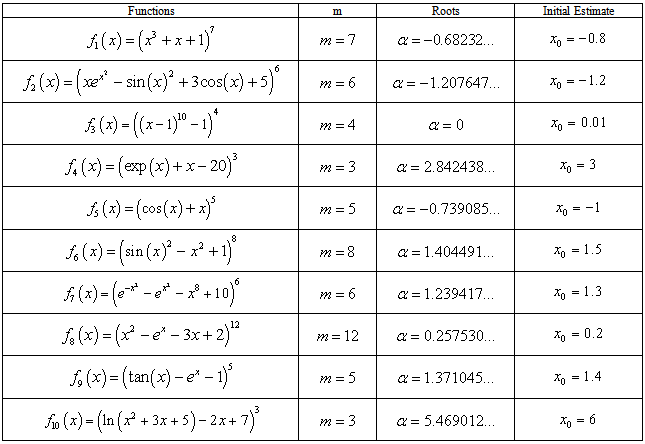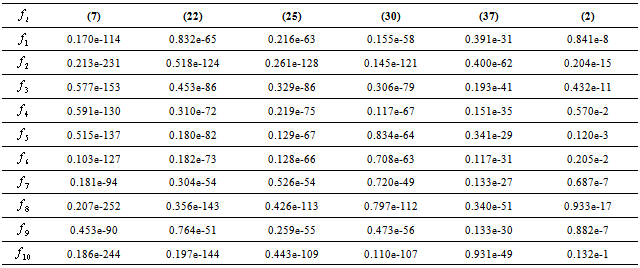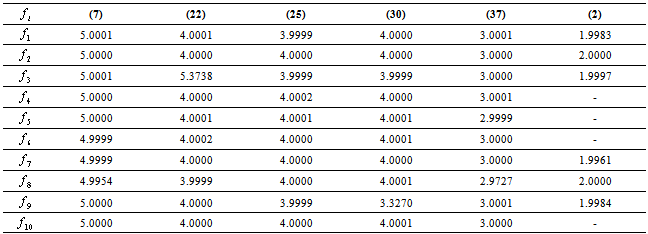R. Thukral
Padé Research Centre, 39 Deanswood Hill, Leeds, West Yorkshire, LS17 5JS, England
Correspondence to: R. Thukral, Padé Research Centre, 39 Deanswood Hill, Leeds, West Yorkshire, LS17 5JS, England.
| Email: |  |
Copyright © 2012 Scientific & Academic Publishing. All Rights Reserved.
Abstract
In this paper, we present a fifth-order method for finding multiple zeros of nonlinear equations. Per iteration, the new method requires two evaluations of functions and two of its first derivative. It is proved that the method has a convergence of order five. Finally, some numerical examples are given to show the performance of the presented method, and compared with some known methods.
Keywords:
Modified Newton Method, Root-Finding, Nonlinear Equations, Multiple Roots, Order of Convergence, Efficiency Index
Cite this paper:
R. Thukral, "A New Fifth-Order Iterative Method for Finding MultipleRoots of Nonlinear Equations", American Journal of Computational and Applied Mathematics, Vol. 2 No. 6, 2012, pp. 260-264. doi: 10.5923/j.ajcam.20120206.04.
1. Introduction
Solving nonlinear equations is one of the most important problems in numerical analysis. In this paper, we consider iterative methods to find a multiple root  of multiplicity m, that is,
of multiplicity m, that is,
 and
and of anonlinear equation
of anonlinear equation  | (1) |
where is a scalar function on an open interval I and it is sufficiently smooth in the neighbourhood of
is a scalar function on an open interval I and it is sufficiently smooth in the neighbourhood of  In recent years, some modifications of the Newton method for multiple roots have been proposed and analysed[1,3,5-7,10]. However, there are not many methods known to handle the case of multiple roots. Hence we present a fifth-order method for finding multiple zeros of a nonlinear equation and only use four evaluations of the function per iteration. In addition, the new methodhas a better efficiency index than the third and fourth order methods given in[1,3,4,7,10]. In view of this fact, the new method is significantly better when compared with the established methods. Consequently, we have found that the new method is efficient and robust.The well-known Newton’s method for finding multiple roots is given by
In recent years, some modifications of the Newton method for multiple roots have been proposed and analysed[1,3,5-7,10]. However, there are not many methods known to handle the case of multiple roots. Hence we present a fifth-order method for finding multiple zeros of a nonlinear equation and only use four evaluations of the function per iteration. In addition, the new methodhas a better efficiency index than the third and fourth order methods given in[1,3,4,7,10]. In view of this fact, the new method is significantly better when compared with the established methods. Consequently, we have found that the new method is efficient and robust.The well-known Newton’s method for finding multiple roots is given by | (2) |
which is quadraticallyconvergent [4]. For the purpose of this paper, we use (2) to construct a new fifth-order method.
2. Development of the Method and Convergence Analysis
In this section we define a new fifth-order method. In order to establish the order of convergence of the new method we state the three essential definitions.Definition 1 Let  be a real function with a simple root
be a real function with a simple root  and let
and let  be a sequence of real numbers that converge towards
be a sequence of real numbers that converge towards  The order of convergence p is given by
The order of convergence p is given by | (3) |
where is the asymptotic error constant and
is the asymptotic error constant and  Definition 2 Let
Definition 2 Let be the number of function evaluations of the new method. The efficiency of the new method is measured by the concept of efficiency index[2,8] and defined as
be the number of function evaluations of the new method. The efficiency of the new method is measured by the concept of efficiency index[2,8] and defined as | (4) |
Definition 3 Suppose that  and
and  are three successive iterations closer to the root
are three successive iterations closer to the root  of (1). Then the computational order of convergence[9]may be approximated by
of (1). Then the computational order of convergence[9]may be approximated by  | (5) |
where The new fifth-order method for finding multiple root of a nonlinear equation is expressed as
The new fifth-order method for finding multiple root of a nonlinear equation is expressed as | (6) |
 | (7) |
Another form of the formula (7) is given by | (8) |
Theorem 1Let  be a multiple root of multiplicity m of a sufficiently differentiable function
be a multiple root of multiplicity m of a sufficiently differentiable function  for an open interval I. If
for an open interval I. If  is sufficiently close to
is sufficiently close to  then the order of convergence of the new method defined by (7) is five.ProofLet
then the order of convergence of the new method defined by (7) is five.ProofLet  be a multiple root of multiplicity m of a sufficiently smooth function
be a multiple root of multiplicity m of a sufficiently smooth function ,
, and
and  , where y is defined in (6).Using the Taylor expansion of
, where y is defined in (6).Using the Taylor expansion of  and
and  about
about  , we have
, we have | (9) |
 | (10) |
where  and
and  | (11) |
Moreover by (6), we have | (12) |
The expansion of  and
and  about
about  are given by
are given by | (13) |
 | (14) |
By using (9) and (13), we get | (15) |
where | (16) |
 | (17) |
Since from (7) we have | (18) |
Substituting appropriate expressions in (18) and after simplification we obtain the error equation | .(19) |
The error equation (19) establishes the fifth-order convergence of the new method defined by (7).
3. The Established Methods
For the purpose of comparison, we consider three fourth-order methods presented recently in[3,10] and the third-order method presented in[7]. Since these methods are well established, we shall state the essential expressions used in order to calculate the approximate solution of the given nonlinear equations and thus compare the effectiveness of the new fifth-ordermethod for multiple roots.
3.1. Wu et al. Method
In[10], Wu et al. developed a fourth-order of convergence method, since this method is well established we state the essential expressions used in the method, | (21) |
 | (22) |
where  ,
,  is the initial value and provided that the denominators of (21)-(22) are not equal to zero.
is the initial value and provided that the denominators of (21)-(22) are not equal to zero.
3.2. Li et al. Method 1
In[3], Li et al. developed some fourth-order convergence methods. The particular method we consider in this paper is expressed by, | (23) |
 | (24) |
 | (25) |
where | (26) |
 | (27) |
 | (28) |
 | (29) |
where  ,
,  is the initial value and provided that the denominators of (23)-(25) are not equal to zero.
is the initial value and provided that the denominators of (23)-(25) are not equal to zero.
3.3. Li et al. Method 2
The second of the fourth-order of convergence method given in[3] is given as, | (30) |
 | (31) |
 | (32) |
where | (33) |
 | (34) |
 | (35) |
where d is given by (29),  ,
,  is the initial value and provided that the denominators of (30)-(32) are not equal to zero.
is the initial value and provided that the denominators of (30)-(32) are not equal to zero.
3.4. Thukral Third-Order Method
In[7], Thukral developed a third-order of convergence method; the particular expressions of the method are given as, | (36) |
 | (37) |
4. Application of the New Fifth-Order Iterative Method
The present fifth-order method given by (7) is employed to solve nonlinear equations with multiple roots and compare with the Wu et al., two of Li et al. and Thukral methods, (22), (25), (30) and (37), respectively. To demonstrate the performance of the newfifth-order method, we use ten particular nonlinear equations. We determine the consistency and stability of results by examining the convergence of the new iterative methods. The findings are generalised by illustrating the effectiveness of the fifth-order methods for determining the multiple root of a nonlinear equation. Consequently, we give estimates of the approximate solution produced by the methods considered and list the errors obtained by each of the methods. The numerical computations listed in the tables were performed on an algebraic system called Maple. In fact, the errors displayed are of absolute value and insignificant approximations by the various methodshave been omitted in the following tables.The new fifth-order method requires four function evaluations and has the order of convergence five. To determine the efficiency index of the new method, we shall use the definition 2. Hence, the efficiency index of the fifth-order method given by (7) is  whereas the efficiency index of the fourth-order and third-order methods is given as
whereas the efficiency index of the fourth-order and third-order methods is given as  and
and respectively. We can see that the efficiency index of the new fifth-order method is better than the other similar methods. The test functions and their exact root
respectively. We can see that the efficiency index of the new fifth-order method is better than the other similar methods. The test functions and their exact root  are displayed in table 1. The difference between the root
are displayed in table 1. The difference between the root  and the approximation
and the approximation  for test functions with initial estimate
for test functions with initial estimate  , are displayed in Table 2. In fact,
, are displayed in Table 2. In fact,  is calculated by using the same total number of function evaluations (TNFE) for all methods. In the calculations, 12 TNFE are used by each method. Furthermore, the computational order of convergence (COC) is displayed in Table 3.
is calculated by using the same total number of function evaluations (TNFE) for all methods. In the calculations, 12 TNFE are used by each method. Furthermore, the computational order of convergence (COC) is displayed in Table 3.Table 1. Test functions and their roots
 |
| |
|
Table 2. Comparison of various iterative methods
 |
| |
|
Table 3. COC of various iterative methods
 |
| |
|
5. Conclusions
In this paper, we have demonstrated the performance of a new fifth-order method for solving nonlinear equations with multiple roots. Convergence analysis proves that the newmethod preserves its order of convergence.Furthermore, we have examined the effectiveness of the new fifth-order iterative method by showing the accuracy of the multiple roots of several nonlinear equations. The main purpose of demonstrating the newmethod fordifferent types of nonlinear equations was purely to illustrate the accuracy of the approximate solution and the computational order of convergence. Finally, the advantages of the new iterative methods are; it is simple to compute, does not contain any long expressions of m, (see Li et al methods),has a better efficiency index than the methods considered and hence it may be considered a very good alternative to the classical methods.
References
| [1] | C. Chun, B. Neta, A third-order modification of Newton’s method for multiple roots, Appl. Math. Comput. 211 (2009) 474-479. |
| [2] | W. Gautschi, Numerical Analysis: an Introduction, Birkhauser, 1997. |
| [3] | S. G. Li, L. Z. Cheng, B. Neta, Some fourth-order nonlinear solvers with closed formulae for multiple roots, Comp. Math. Appl. 58 (2010) 126-135. |
| [4] | E. Schroder, Uber unendich viele Algorithmen zur Auflosung der Gleichungen, Math. Ann. 2 (1870) 317-365. |
| [5] | J. R. Sharma, R. Sharma, Modified Jarratt method for computing multiple roots, Appl. Math. Comput. 217 (2010) 878-881. |
| [6] | L. Shengguo, L. Xiangke, C. Lizhi, A new fourth-order iterative method for finding multiple roots of nonlinear equations, Appl. Math. Comput. 215 (2009) 1288-1292. |
| [7] | R. Thukral, A new third-order iterative method for solving nonlinear equations with multiple roots, J. Math. Comput. 6 (2010) 61-68. |
| [8] | J. F. Traub, Iterative Methods for solution of equations, Chelsea publishing company, New York 1977. |
| [9] | S. Weerakoon, T. G. I. Fernando, A variant of Newton’s method with accelerated third-order convergence, Appl. Math. Lett. 13 (2000) 87-93. |
| [10] | Z. Wu, X. Li, A fourth-order modification of Newton’s method for multiple roots, IJRRAS 10 (2) (2012) 166-170. |

 of multiplicity m, that is,
of multiplicity m, that is,
 and
and of anonlinear equation
of anonlinear equation 
 is a scalar function on an open interval I and it is sufficiently smooth in the neighbourhood of
is a scalar function on an open interval I and it is sufficiently smooth in the neighbourhood of  In recent years, some modifications of the Newton method for multiple roots have been proposed and analysed[1,3,5-7,10]. However, there are not many methods known to handle the case of multiple roots. Hence we present a fifth-order method for finding multiple zeros of a nonlinear equation and only use four evaluations of the function per iteration. In addition, the new methodhas a better efficiency index than the third and fourth order methods given in[1,3,4,7,10]. In view of this fact, the new method is significantly better when compared with the established methods. Consequently, we have found that the new method is efficient and robust.The well-known Newton’s method for finding multiple roots is given by
In recent years, some modifications of the Newton method for multiple roots have been proposed and analysed[1,3,5-7,10]. However, there are not many methods known to handle the case of multiple roots. Hence we present a fifth-order method for finding multiple zeros of a nonlinear equation and only use four evaluations of the function per iteration. In addition, the new methodhas a better efficiency index than the third and fourth order methods given in[1,3,4,7,10]. In view of this fact, the new method is significantly better when compared with the established methods. Consequently, we have found that the new method is efficient and robust.The well-known Newton’s method for finding multiple roots is given by
 be a real function with a simple root
be a real function with a simple root  and let
and let  be a sequence of real numbers that converge towards
be a sequence of real numbers that converge towards  The order of convergence p is given by
The order of convergence p is given by
 is the asymptotic error constant and
is the asymptotic error constant and  Definition 2 Let
Definition 2 Let be the number of function evaluations of the new method. The efficiency of the new method is measured by the concept of efficiency index[2,8] and defined as
be the number of function evaluations of the new method. The efficiency of the new method is measured by the concept of efficiency index[2,8] and defined as
 and
and  are three successive iterations closer to the root
are three successive iterations closer to the root  of (1). Then the computational order of convergence[9]may be approximated by
of (1). Then the computational order of convergence[9]may be approximated by 
 The new fifth-order method for finding multiple root of a nonlinear equation is expressed as
The new fifth-order method for finding multiple root of a nonlinear equation is expressed as


 be a multiple root of multiplicity m of a sufficiently differentiable function
be a multiple root of multiplicity m of a sufficiently differentiable function  for an open interval I. If
for an open interval I. If  is sufficiently close to
is sufficiently close to  then the order of convergence of the new method defined by (7) is five.ProofLet
then the order of convergence of the new method defined by (7) is five.ProofLet  be a multiple root of multiplicity m of a sufficiently smooth function
be a multiple root of multiplicity m of a sufficiently smooth function ,
, and
and  , where y is defined in (6).Using the Taylor expansion of
, where y is defined in (6).Using the Taylor expansion of  and
and  about
about  , we have
, we have

 and
and 

 and
and  about
about  are given by
are given by








 ,
,  is the initial value and provided that the denominators of (21)-(22) are not equal to zero.
is the initial value and provided that the denominators of (21)-(22) are not equal to zero. 






 ,
,  is the initial value and provided that the denominators of (23)-(25) are not equal to zero.
is the initial value and provided that the denominators of (23)-(25) are not equal to zero.





 ,
,  is the initial value and provided that the denominators of (30)-(32) are not equal to zero.
is the initial value and provided that the denominators of (30)-(32) are not equal to zero.

 whereas the efficiency index of the fourth-order and third-order methods is given as
whereas the efficiency index of the fourth-order and third-order methods is given as  and
and respectively. We can see that the efficiency index of the new fifth-order method is better than the other similar methods. The test functions and their exact root
respectively. We can see that the efficiency index of the new fifth-order method is better than the other similar methods. The test functions and their exact root  are displayed in table 1. The difference between the root
are displayed in table 1. The difference between the root  and the approximation
and the approximation  for test functions with initial estimate
for test functions with initial estimate  , are displayed in Table 2. In fact,
, are displayed in Table 2. In fact,  is calculated by using the same total number of function evaluations (TNFE) for all methods. In the calculations, 12 TNFE are used by each method. Furthermore, the computational order of convergence (COC) is displayed in Table 3.
is calculated by using the same total number of function evaluations (TNFE) for all methods. In the calculations, 12 TNFE are used by each method. Furthermore, the computational order of convergence (COC) is displayed in Table 3. Abstract
Abstract Reference
Reference Full-Text PDF
Full-Text PDF Full-Text HTML
Full-Text HTML

